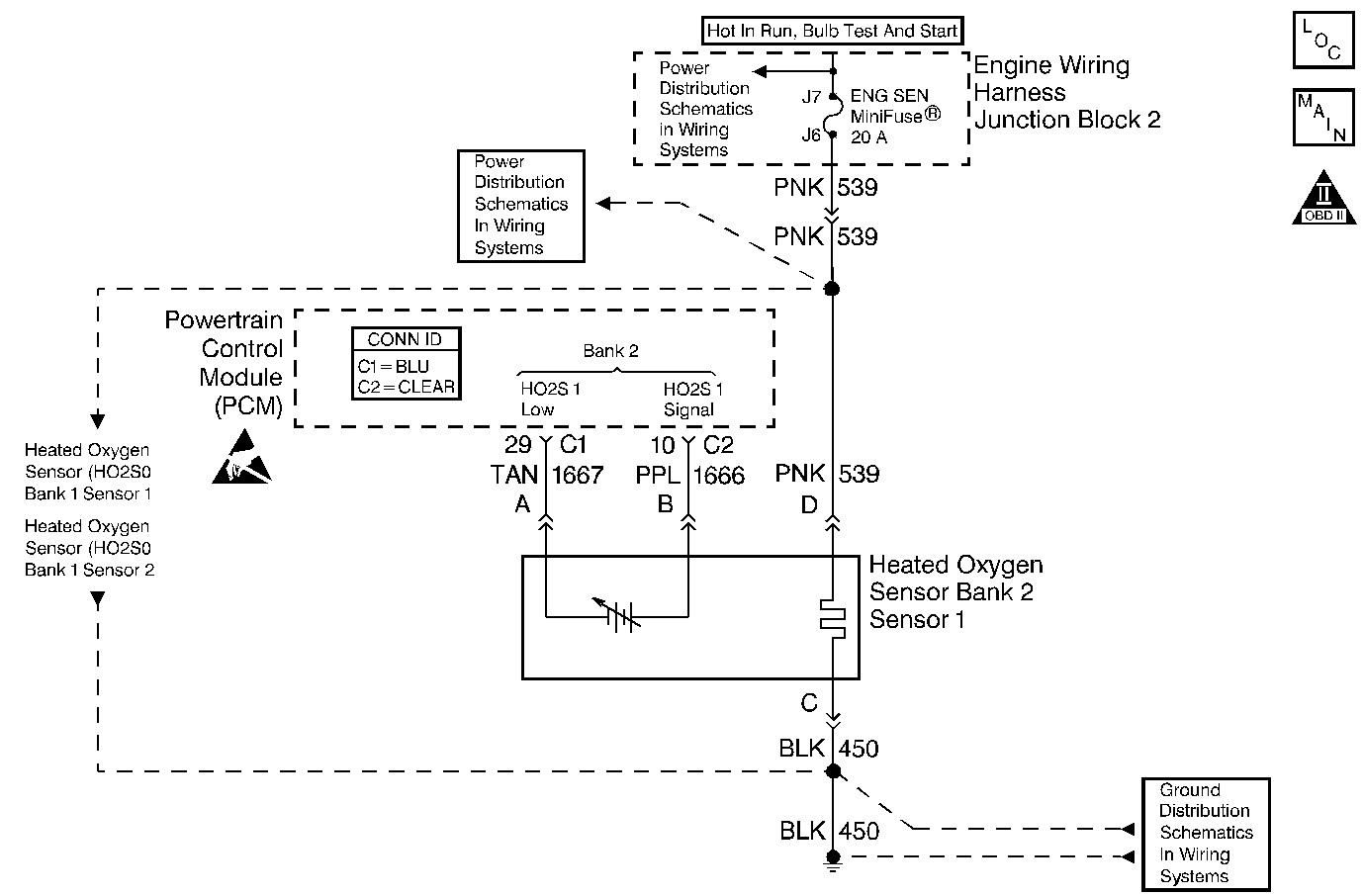
Circuit Description
The PCM supplies a bias voltage of about 450 mV between the HO2S signal and low circuits. When measured with a DMM, this may display as low as 350 mV. The oxygen sensor varies the voltage within a range of about 1000 mV when the exhaust is rich, down through about 100 mV when exhaust is lean. The PCM constantly monitors the HO2S signal during closed loop operation and compensates for a rich or lean condition by decreasing or increasing injector pulse width as necessary. If the HO2S voltage remains excessively low for an extended period of time, this DTC will be set.
Conditions for Running the DTC
| • | No Misfire, CKP, Fuel injector, MAF, TP, EVAP, IAT, MAP, Fuel trim, EGR or ECT DTCs are present. |
| • | The vehicle is in closed loop. |
| • | The Air/Fuel Ratio is more than or equal to 14.5 but less than or equal to 14.8 |
| • | Throttle angle is between 5 percent and 40 percent |
Conditions for Setting the DTC
HO2S signal voltage remains less than 175 mV during normal closed loop operation
OR
HO2S signal voltage remains less than 6000 mV during power enrichment.
Action Taken When the DTC Sets
| • | The PCM will illuminate the malfunction indicator lamp (MIL) during the second consecutive trip in which the diagnostic test has been run and failed. |
| • | The PCM will store conditions which were present when the DTC set as Freeze Frame/Failure Records data. |
Conditions for Clearing the MIL/DTC
| • | The PCM will turn OFF the malfunction indicator lamp (MIL) during the third consecutive trip in which the diagnostic has run and passed. |
| • | The history DTC will clear after 40 consecutive warm-up cycles have occurred without a malfunction. |
| • | The DTC can be cleared by using a scan tool. |
Diagnostic Aids
Inspect for the following:
| • | Throttle body inlet screen blockage |
| • | Low fuel pressure -- The system will go lean if pressure is too low. The PCM can compensate for some decrease. However, if fuel pressure is too low, a HO2S DTC may set. Refer to Fuel System Pressure Test . |
| • | Fuel injectors contaminated or faulty -- Refer to Fuel Injector Balance Test . |
| • | Exhaust leaks -- An exhaust leak may cause outside air to be pulled into the exhaust gas stream past the HO2S, causing the system to appear lean. Inspect for exhaust leaks that may cause a false lean condition to be indicated. |
| • | Faulty MAF sensor -- Disconnect the MAF sensor and see if the lean condition is corrected. If so, replace the MAF sensor. |
| • | Fuel contamination -- Water, even in small amounts, can be delivered to the fuel injectors. The water can cause a lean exhaust to be indicated. Excessive alcohol in the fuel can also cause this condition. Refer to Alcohol/Contaminants-in-Fuel Diagnosis . |
If none of the above conditions are present, replace the affected HO2S.
If the DTC is determined to be intermittent, reviewing the Fail Records can be useful in determining when the DTC was last set.
Test Description
The numbers below refer to step numbers on the diagnostic table:
-
This DTC failing during power enrichment operation (TP angle above 60 percent) may indicate a condition described in Diagnostic Aids. If this DTC test passes while the Fail Records conditions are being duplicated, an intermittent condition is indicated. Review the Fail Records vehicle mileage since the diagnostic test last failed. This may help determine how often the condition that caused the DTC to be set occurs.
-
This vehicle is equipped with a PCM which utilizes an Electrically Erasable Programmable Read Only Memory (EEPROM). When the PCM is replaced, the new PCM must be programmed.
Step | Action | Values | Yes | No |
|---|---|---|---|---|
1 | Did you perform the Powertrain On-Board Diagnostic (OBD) System Check? | -- | ||
2 |
Important: During this step, observe all HO2S voltage parameters. If all parameters remain below the specified value, refer to Diagnostic Aids.
Does the HO2S voltage remain below the specified value? | 400 mV | ||
Operate vehicle within Fail Records conditions. Does the scan tool indicate this DTC failed this ignition? | -- | Go to Diagnostic Aids | ||
4 |
Does scan tool indicate HO2S voltage less than the specified value? | 400 mV | ||
5 | Test the HO2S signal circuit for a short to ground or a short to the sensor ground circuit. Refer to Circuit Testing and Wiring Repairs in Wiring Systems. Did you find and correct the condition? | -- | ||
|
Important: The replacement PCM must be programmed. Replace the PCM. Refer to Powertrain Control Module Replacement/Programming . Did you complete the repair? | -- | -- | ||
7 | Replace the HO2S. Refer to Heated Oxygen Sensor Replacement . Did you complete the repair? | -- | -- | |
8 |
Does the DTC reset? | -- | System OK |
